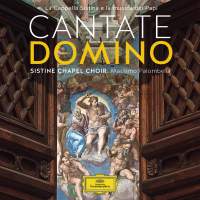Texte paru dans: / Appeared in: |
||||
|
Outil de traduction ~ (Très approximatif) |
||||
|
Reviewer: J.
F. Weber Fr. Massimo Palombella (b. 1967) has been director of the Sistine Choir since 2010, succeeding Giuseppe Liberto, who held the post for 13 years. The choir’s quality has risen successively through the terms of these two directors to achieve a level of excellence unknown for many decades. It is no surprise that few recordings were made during those decades, one exception being The Vatican Celebrates Holy Week, a lamentable album of four LPs recorded live in 1966 by the English firm Ryemuse. No better proof of the poor choice of music and quality of singing of that era will be found. Now we can hear some of the great works of the Roman School sung worthily by the successor of the choir for which they were written. Certainly the single work that makes this program exceptional is Gregorio Allegri’s Miserere, written for the Sistine Choir and recorded many times in various versions. Here it is “sung from manuscripts held in the Sistine Chapel archives.” It is similar to the more familiar recordings but lacking the soaring high passages that have become such a thrilling aspect of the work. But the authenticity of this version cannot be denied, and afficionados must hear it for comparison. Since the entire recording was made in the Sistine Chapel, the solo quartet in the Miserere sings from the Sala Regia, a room next to the chapel, to good spatial effect. The CD is being advertised as the first recording ever made in the Sistine Chapel. That is false, for in 1980, as part of a celebrated broadcast series of 10 liturgical reconstructions of Masses for the octave of Christmas, the BBC employed Gavin Turner’s William Byrd Choir to recreate a papal Mass of December 31, 1613, the feast of St. Sylvester. (The other nine reconstructions used different choirs in different venues as far-flung as Reims, Milan, and Mexico City, with repertoire dating from the ninth to the 17th century.) I have it on LP (BBC Artium REGL 572), the only one of the 10 broadcasts issued commercially, but it later appeared on CD with the same number. Turner placed his choir in the choir space, recessed into the side wall of the chapel, which made it difficult to capture the acoustics of the chapel adequately. Here photos show the choir placed more advantageously, so the acoustics are very resonant, comparable to many larger Romanesque churches that were built for Cistercian abbeys. The spatial effects in the Allegri work are captured to great advantage, and the chant, sung according to current semiological principles, benefits from the aura surrounding the voices. Other works include Ad te levavi, Improperium exspectavit, Angelus Domini, and Constitues eos, four among Palestrina’s offertories for the entire year that were published just before his death. Lassus is something of an outsider, for the year that he spent as maestro at St. John Lateran hardly ranked him as a composer of the Roman School, but the Magnificat of 1567 heard here is typical of the high Renaissance in Rome, as is his Iubilate Deo omnis terra of 1585. Victoria, for all his productive 20 years in Rome, is represented only by Popule meus from his masterly Officium Hebdomadae Sanctae. Felice Anerio (c. 1560–1614) contributes the Holy Week gradual Christus factus est. The rest of the disc is devoted to Palestrina and three familiar Gregorian chants. Everything is designed to show the course of the liturgical year from Advent to the end of June, Palestrina’s offertories being particularly apt for that purpose. The choice of music is a far cry from the dreary works of Lorenzo Perosi and Domenico Bartolucci, who preferred their own creations to such masterpieces as are heard here. The singing tone has obviously benefitted from the exchange visits in London and Rome with the choir of Westminster Cathedral, arguably the finest Catholic cathedral choir in the world. The boys’ urchinly voices have given way to a new generation of boys properly trained; the men now include high tenors on the alto line (the works transposed to suit). Palombella writes in the notes that his choir now avoids both “the black and white vision of many northern European performances, and the late-Romantic, operatic vision with which for many (too many) years the Sistine Chapel Choir was associated, believing it was passing on to posterity the only true style of the ‘Roman school’.” Criticism from within is more convincing than all that has been said and written about the choir in past years. All in all, this disc is a triumph for its director, as well as for everyone who can now look to the Vatican for the musical leadership in Catholic church music that is expected. The last time that was the case was over a century ago, when St. Pius X brought down from Venice a director (Perosi) who was then of sound mind. Among other salutary changes, he replaced castrati with boys. Anyone who is interested in Roman church music must hear this disc. It is astonishing. | ||||
|
||||
|
|
|
|||
|
Cliquez l'un ou l'autre
bouton pour découvrir bien d'autres critiques de CD |
||||




